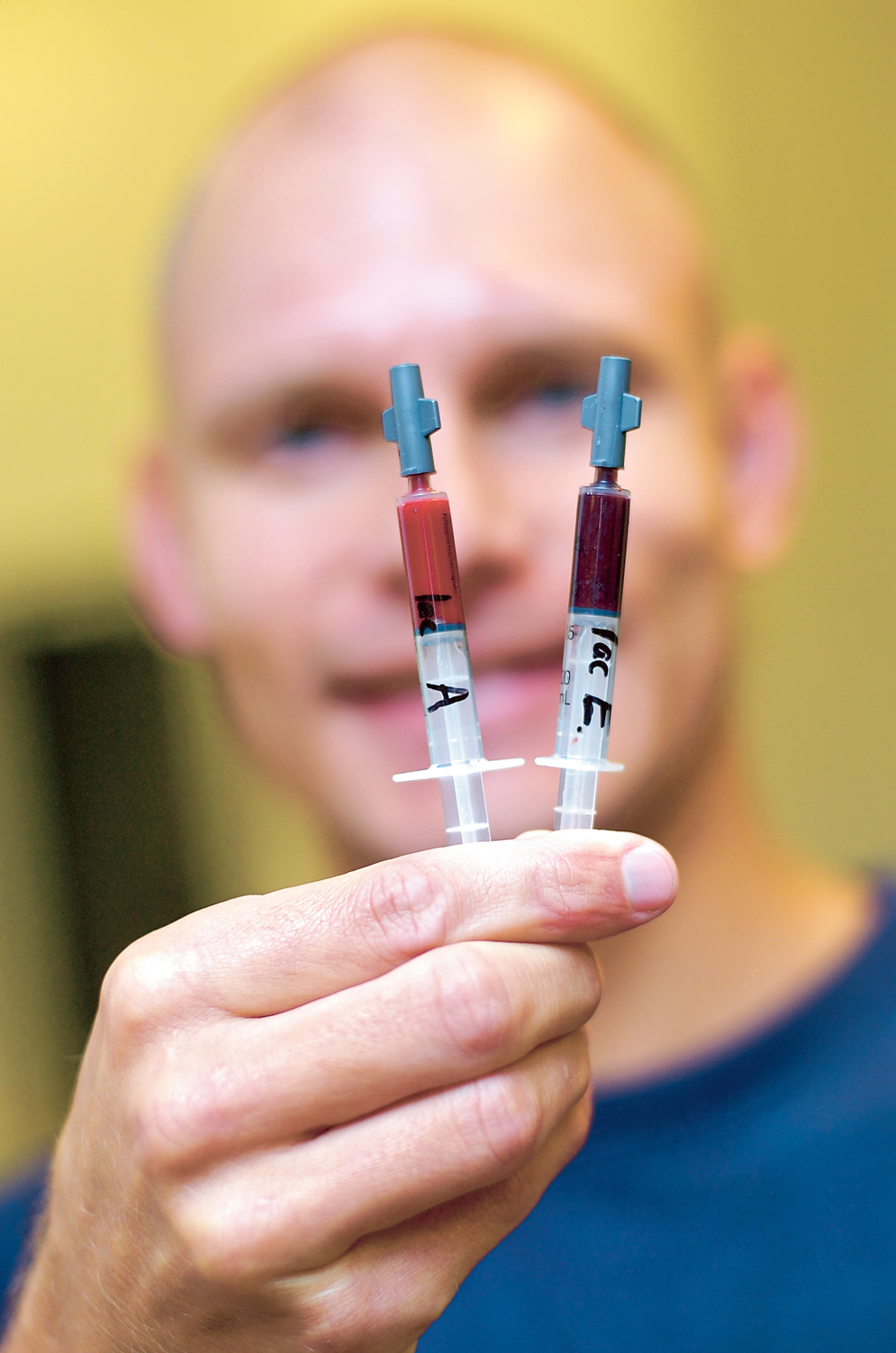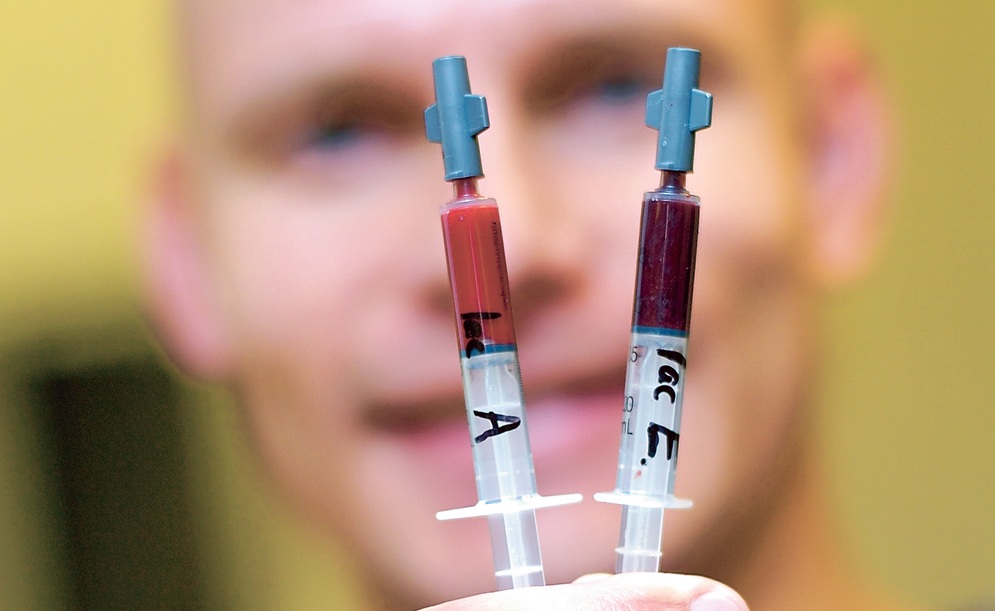Articles
Blood – Natural Doping!
Update
A new study from 2024 corroborates the main point of this article of how breath-holding can increase the hematocrit value of the blood for increased athletic performance:
“Acute ergogenic effects of repetitive maximal breath-holding maneuvers on hematological and physiological responses: a graded exercise test investigation” – Y Christoulas · 2024
The main role of blood
When you breathe and air enters your lungs, oxygen is delivered via your blood, to every cell in your body. Here, oxygen is consumed in the Krebs cycle (citric acid cycle), which is a cascade of chemical reactions involving the transformation of the food you have eaten to energy-rich molecules called ATP (the cell’s battery) by means of water and enzymes. A byproduct of this cycle is carbon dioxide which blood transports to the lungs where it is released to the atmosphere upon exhalation. One can compare the red blood cells to a lot of small buses that whiz around the body. As soon as they have delivered their cargo of oxygen to the cells, they bring carbon dioxide back to the lungs. It is very important that the relationship between these two gases are in equilibrium.
Blood components
Our body contains about 4-5 liters of blood that is circulated by our heart. A cycle takes approx. 1 minute. Apart from blood being very important for thermoregulation, it also transports a number of substances such as dissolved food molecules (sugar, fat and amino acids), salts, hormones, waste products and especially red and white blood cells. The white blood cells (also called leucocytes) are an important part of our immune system and aid in keeping the body healthy. The red blood cells, erythrocytes, contain the hemoglobin (Hb) molecule that binds oxygen and carbon dioxide.
Red blood cells are formed in the bone marrow of large bones throughout life. Approx. 2 million to 3 million of them are formed every second, and just as many are broken down every second in the liver. The kidney produces a natural compound, erythropoietin, better known by the acronym EPO, which increases the formation of red blood cells. If one acquires a blood test and centrifuges the blood, it will divide into 3 layers. At the top the yellowish plasma, in the middle a narrow white band consisting of white blood cells, and at the bottom the red blood cells aggregate. The fraction of red blood cells is also called the hematocrit value (Hct) and it should comprise about 45%.
Increasing your hematocrit
If you inject EPO into your blood stream, the hematocrit value will increase significantly (up to approx. 60%), and this is exactly how some athletes try to improve their performance in their pursuit of prestige and money. Besides from being deeply unethical, it is also dangerous because blood can become so thick that it can be difficult to maintain a flow through the body’s many fine blood vessels. Another form of cheating is “blood doping”. In this technique a portion of the athletes blood is retrieved and the hemoglobin is separated from the blood and frozen. Just prior to a competition these red blood cells are then injected back into the bloodstream. The effect is equal to EPO injection – and the same applies to the risks involved.

If the athlete instead trained his or her breathing and used recognized forms of training such as yoga, freediving and altitude training, combined with proper food intake, he or she would achieve a similar effect – just taking a longer and safer acclimatization period. And no cheating!
Blood acidity
Life depends on maintaining the environment in each living cell within certain parameters. A good example of this is our body temperature and the acidity of our blood, which should be maintained around a pH value of 7.4 (an acceptable level is 7.35 to 7.45). Our breathing is crucial to this balance. By varying our breath under different circumstances, the concentration of carbon dioxide (CO2) and thus the amount of hydrogen ions (H+), which determines the blood pH, can be regulated. If breathing alone cannot maintain stability, the kidney is able to take up or release H+ and thereby re-establish the balance. If pH moves much above or below approx. 7.4, it can seriously affect our bodily functions.
It is not the blood alone that has to maintain a certain pH balance. It is also crucial for the rest of the body’s tissue and bones. This pH or “acid-base” balance is, to a great extent, dictated by the food you consume. Within modern medicine this topic has achieved very little attention, since the emphasis in nutrition is on the energy in protein, fat and carbohydrates (kcal). However, the positive effect of base-forming foods such as vegetables, fruits and nuts is receiving more attention. In contrast, sugar, fat and protein are acid-forming.
Oxygen reserves in our muscles
Besides the amount of oxygen that is bound to our red blood cells and the oxygen we have in our lungs, we also have an oxygen reserve in our muscles called myoglobin. Aquatic mammals such as seals and whales that often perform prolonged and deep foraging dives have high concentrations of myoglobin. Along with a high concentration of red blood cells, erythrocytes, these animals can hold their breath for nearly one hour. In addition, these aquatic mammals also exhibit a pronounced diving response that also has been retained in terrestrial mammals – including human beings.
The diving response is initiated when the body and particularly the face contacts water and is amplified when the body dives deeper and deeper into water. The diving response includes a number of mechanisms that all contribute to prolonging the period of time the body can survive without extra oxygen. In other words one can say that the diving response economizes with the oxygen at hand.
If you liked this article you are most welcome to share it with your friends…
Breatheology Courses
Learn and master conscious breathing through our online learning programs. Discover how effective, simple techniques can help boost your performance, help you feel more balanced, and improve your well-being.
Free Courses
Kickstart your breathwork journey with our free, step-by-step training programs.
Level Up Your Skills
Take your breathwork to new heights with our advanced courses and feel the difference in your mind and body.
